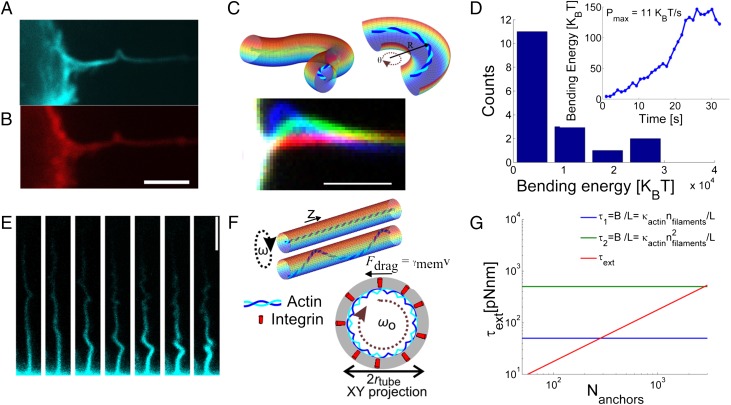Fig. 3.
Helical bending dynamics of actin filaments inside filopodia. (A and B) Bending of the F-actin (A) also induces a local bending of the membrane (labeled with DiD) as shown in B. (Scale bar: 3 μm.) (C) Plot of a tube, containing F-actin, which is bent into an arc of radius R. The overlay images below show progressive buckling of an actin bundle near the cell body. The colors represent three different relative time points at tred = 0 s, tgreen = 13 s, and tblue = 30 s. (Scale bar: 2 μm.) (D) Histogram of the maximum bending energy calculated from n = 17 filopodia displaying different degrees of bending. The energy is calculated assuming a bundle of 10 parallel actin filaments. The Inset shows the progressive increase in curvature energy versus time for the single buckle shown in C. The highest power consumed to bend the actin bundle reaches 11 KBT/s. (E) Example of a coiled actin structure inside a filopodium captured at different time points separated by 2 s. (Scale bar: 3 μm.) See also Movie S3. (F) Axial rotation of the actin within the membrane tube leads to friction between the membrane and the actin. Two initial scenarios depicting an actin filament within a membrane tube. In a filopodium, the actin will align along the inner membrane either as a straight rod (upper sketch) or a deformed shape, possibly a helix (lower sketch), within the tube. We model the actin–membrane linkages as connections between the actin and transmembrane integrins as shown by the XY projection of the membrane tube with an actin filament tracing a helix (with same radius as the tube) within the tube. The integrins (red cylinders) are dragged through the membrane by the rotating actin filament. (G) The total external torque on the actin shaft depends linearly on the number of anchors, Nanchors, connecting the actin with the membrane. Two critical buckling torques, τcrit, are plotted by the horizontal lines; these correspond to an actin shaft consisting of 10 actin filaments that are cross-linked (green line) or not cross-linked (blue line).

